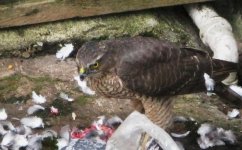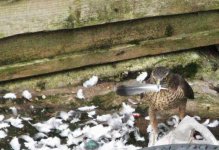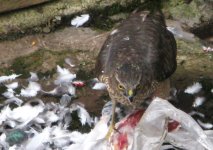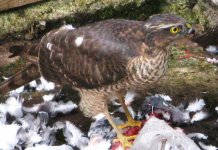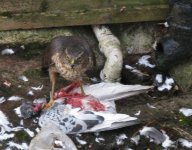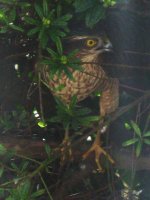-
Welcome to BirdForum, the internet's largest birding community with thousands of members from all over the world. The forums are dedicated to wild birds, birding, binoculars and equipment and all that goes with it.
Please register for an account to take part in the discussions in the forum, post your pictures in the gallery and more.
You are using an out of date browser. It may not display this or other websites correctly.
You should upgrade or use an alternative browser.
You should upgrade or use an alternative browser.
Sparrowhawk tactics (1 Viewer)
- Thread starter ChrisKten
- Start date
More options
Who Replied?ChrisKten
It's true, I quite like Pigeons
I'm glad this interests some of you.
I plan to set up my video camera so it's connected to my Laptop. This will mean I can record for 12+ hours a day.
All being well, I should be able to capture the Sparrowhawks' attacks on video, rather than just after the attacks. The only thing preventing this is I use my Laptop for other tasks, but I will sort it out soon. In fact I may connect the camera to a spare PC I have.
As a side note, the population of prey in my garden is either the same, or has increased, over the last 2 years. So please don't frighten the Hawks away, they really don't have a detrimental effect on bird populations; not in my experience at least.
EDIT: The last sentence above was obviously not aimed at posters in this thread.
I plan to set up my video camera so it's connected to my Laptop. This will mean I can record for 12+ hours a day.
All being well, I should be able to capture the Sparrowhawks' attacks on video, rather than just after the attacks. The only thing preventing this is I use my Laptop for other tasks, but I will sort it out soon. In fact I may connect the camera to a spare PC I have.
As a side note, the population of prey in my garden is either the same, or has increased, over the last 2 years. So please don't frighten the Hawks away, they really don't have a detrimental effect on bird populations; not in my experience at least.
EDIT: The last sentence above was obviously not aimed at posters in this thread.
Last edited:
mikfoz
It's not a competition. Watch the birdy!
As a side note, the population of prey in my garden is either the same, or has increased, over the last 2 years. [highlight]So please don't frighten the Hawks away, they really don't have a detrimental effect on bird populations; not in my experience at least.[/highlight]
And so say all of us! Keep up your good work.
James Bean
Well-known member
ChrisKten: Your account and pictures of Sparrowhawks prompt me to add a similar event last Thursday, 5th March, when I witnessed a Sparrowhawk killing a Pigeon on the path of the house next door. The Sparrowhawk took its prey behind a bin and then tore the Pigeon to pieces, feathers flying everywhere. Thinking it was unseen, the Sparrowhawk then spent about 40 minutes eating its lunch, not knowing I was watching (with bated breath) from a bedroom window. I had seen a similar kill a couple of years ago, at the bottom of my rear garden; that too had been a Sparrowhawk feasting on a Pigeon, and taking half an hour or more to do so. It seems Sparrowhawks like to settle into a corner so they know their back is protected, and then follow a regular routine of eating/looking every few seconds, for as long as it takes to finish their bloody meal; not very pleasant to watch, but that's nature in the raw, and fascinating. The latest incident had a touch of humour, to relieve the gory scene: while the Sparrowhawk was ripping feathers from the carcase, a Blackbird happened to land on the fence nearby and initially didn't notice the carnage a few feet beneath him; then the realisation dawned, and the look on the Blackbird's face was, literally, "shock/horror"... I don't recall hearing a sonic boom, but I have never seen a Blackbird take off so fast... equalled only, maybe, by an Avro Vulcan in a vertical climb!
ChrisKten
It's true, I quite like Pigeons
ChrisKten: Your account and pictures of Sparrowhawks prompt me to add a similar event last Thursday, 5th March, when I witnessed a Sparrowhawk killing a Pigeon on the path of the house next door. The Sparrowhawk took its prey behind a bin and then tore the Pigeon to pieces, feathers flying everywhere. Thinking it was unseen, the Sparrowhawk then spent about 40 minutes eating its lunch, not knowing I was watching (with bated breath) from a bedroom window. I had seen a similar kill a couple of years ago, at the bottom of my rear garden; that too had been a Sparrowhawk feasting on a Pigeon, and taking half an hour or more to do so. It seems Sparrowhawks like to settle into a corner so they know their back is protected, and then follow a regular routine of eating/looking every few seconds, for as long as it takes to finish their bloody meal; not very pleasant to watch, but that's nature in the raw, and fascinating. The latest incident had a touch of humour, to relieve the gory scene: while the Sparrowhawk was ripping feathers from the carcase, a Blackbird happened to land on the fence nearby and initially didn't notice the carnage a few feet beneath him; then the realisation dawned, and the look on the Blackbird's face was, literally, "shock/horror"... I don't recall hearing a sonic boom, but I have never seen a Blackbird take off so fast... equalled only, maybe, by an Avro Vulcan in a vertical climb!
Yes we are very lucky people. Some travel to Africa to see a wild animal killing it's prey, we don't even need to walk a step.
I can almost see the Blackbird's reaction from what you described. I've seen an almost identical (though I bet much louder) reaction from a Jay that landed on the fence above a feeding Sparrowhawk. The noise the Jay made started off the other Jays nearby; it didn't seem to bother the Sparrowhawk though.
lockbreeze926
Well-known member

In north America the pics on this thread would not be a sparrow hawk. and what ticks me off is they changed our"sparrow Hawk" to American kestrel" i guess i am getting old. Dave
Well, this is a regular topic and some of it is just down to the old tomato/tomayto type of distinction, and neither side of the Atlantic has a monopoly on accuracy.
For instance, I think the North American "loon" is far more evocative and satisfactory than "diver", likewise calling Scoters black or white-winged, as Americans do, is far more logical than common or velvet; however, I do prefer the term "skua" to "jaeger", so there is something to gain by moving in both directions.
However, there are some cases where the original north American names are simply, er, wrong, and were awarded by early settlers based on superficial resemblances to things they knew from Europe - most obviously, the American Robin. The Am Kestrel is one such case where the name did need to be changed - it is just not any sort of a hawk, either a true hawk such as accipiter or even a N American hawk of the buteo type. The same applied to the Northern Harrier, that was likewise never a hawk, and also to the vultures, which were never any kind of "buzzard", although this term is still in use.
, and also to the (New World) vultures, which were never any kind of "buzzard", although this term is still in use.
Actually, they're not any kind of "vulture" either, but belong to a New World family unrelated to the Old World vultures. If we want to be "accurate" we have to adopt or invent a new name for them--"condors" maybe?. As far as I can tell there's no end to the kind of pedantry you seem to espouse. New World "blackbirds" aren't "really" blackbirds (they're not related to the birds Europeans call "blackbirds"); ditto for New World "sparrows" ( = Old World "buntings" ) & New World warblers (not related to Old World "warblers"). And, of course, that old favorite, "hawks" not "buzzards" for NW buteos.
Names are just labels, you know, mutually agreed upon by the speakers of a language or dialect. They don't really "mean" anything. They also change all the time. Most of the characteristically American bird names weren't invented there but were introduced by the early settlers at a time before there was anything like a standardized list in the old country.
Well this has sure drifting off topic isn't it, as always seems to happen to threads when trans-Atlantic differences in bird names are introduced?
lockbreeze926
Well-known member

As far as I can tell there's no end to the kind of pedantry you seem to espouse.
Names are just labels, you know,
Hi fugl, that stuff is just mean.
(and manners cost nothing, you know.)
Hi fugl, that stuff is just mean
I think you need to lighten up. What's so "mean" about "pedant"? In another thread I apply the word to myself. And the label remark? What's offensive about that? You're the one, after all, who described the OP as "simply, er, wrong", & I was just setting you straight.
James Bean
Well-known member
Pictures of Sparrowhawk eating Pigeon on 5th March, Chester.
Taken with Canon G9 handheld at extreme telephoto range.
Taken with Canon G9 handheld at extreme telephoto range.
Attachments
Bananafishbones
Incoherently Rambling .....

"Now wheres my napkin"
Thats what you call a mess!!
Thats what you call a mess!!
Birdbrain
"Birders do it in the Field"

Gutted
In my old garden i had this Robin that i feed mealworm for a year, in the end he/she came to my hand to feed, then one day (you know what im going to say now dont you) looking out of my window a female Sparrowhawk was munching on my Robin :eek!: i was to late :-C i was devastated :-C
But one thing is when you feed the birds you feed the birds :t:
In my old garden i had this Robin that i feed mealworm for a year, in the end he/she came to my hand to feed, then one day (you know what im going to say now dont you) looking out of my window a female Sparrowhawk was munching on my Robin :eek!: i was to late :-C i was devastated :-C
But one thing is when you feed the birds you feed the birds :t:
ChrisKten
It's true, I quite like Pigeons
Anyway James ain't that a feral pigeon ? one less ay ?
I actually quite like Pigeons, even feral ones.
If you observe them you'll find that they are highly intelligent. I spent 2 years trying to stop them getting at the seed and nuts. I hung small trays in the trees, put trays of monkey nuts in the trees for Squirrels, Tits, and Jays. Whatever I tried, they found a way to get at the food; they even dig up the garden to find nuts the Squirrels bury (I mentioned this behaviour in another thread). They have also trained the Squirrels (by bullying them) to leave them one nut from each of the nuts in shells.
I have seen them with one leg, half a leg, no toes, hobbled by string that was left lying around. They get shot at by bored teenagers, poisoned by people that believe they are flying rats.
If you measure intelligence by the ability to survive extreme hardship they are one of the most intelligent birds I've seen.
All I'm saying is, a Bird is a Bird, I'm never happy seeing a Bird, or any animal, suffer.
ChrisKten
It's true, I quite like Pigeons
I do like all birds ! i always feed the pigeons when i go to town and have chips and gravy ? YUM it is very funny watching them throwing them all over the place !
The thing that makes me LOL is after they've mated. The male follows the female everywhere, and at speed. When they are running around it's like they are joined by invisible string. The male also frequently pecks the female to keep her away from other males.
James Bean
Well-known member
Another picture of the Sparrowhawk: after killing and eating a Pigeon, on 5th March in Chester, it then flew to a tree in my garden where it 'skulked' for a few minutes before flying off. I was very lucky to get this picture because the Sparrowhawk was only in full view for a matter of seconds; note it still has the Pigeon's blood on its talons.
Attachments
ChrisKten
It's true, I quite like Pigeons
Another picture of the Sparrowhawk: after killing and eating a Pigeon, on 5th March in Chester, it then flew to a tree in my garden where it 'skulked' for a few minutes before flying off. I was very lucky to get this picture because the Sparrowhawk was only in full view for a matter of seconds; note it still has the Pigeon's blood on its talons.
Was you lucky enough to see the attack? Did you see where the attack came from? Was the Pigeon ill, isolated, or amongst other Pigeons?
Just curious, as it might help to compare with the experiences I've posted here.
James Bean
Well-known member
I didn't see the initial attack. My attention was drawn by the 'kerfuffle' outside. I looked out my kitchen window to see what all the fuss was about and there were no birds at all in my back garden, which was unusual, just sounds of agitation from hidden birds. I first thought it was maybe a cat, so I looked out my side window onto my long drive (typical escape route for local cats) but saw nothing, so I went upstairs for a better view. Still nothing, but then I noticed movement on next-door's drive, so leaned out of the window and saw the Sparrowhawk dragging the Pigeon, which may still have been alive, behind a bin in the corner. I grabbed my binoculars from another room and by the time I could get a good view the Pigeon was probably deceased, since the only movement was the Sparrowhawk ripping feathers off it. So I raced downstairs for my camera, then spent a half-hour or more trying to obtain shots of the carnage at extreme telephoto range, not easy because I didn't want to disturb the Sparrowhawk and I was half-hanging out of a window, sideways on! Some time later, a Blackbird alighted on my fence, oblivious to the goings-on below, but then it turned its head and I wish I'd had time to picture the look of dismay on its face! When the Sparrowhawk had eventually eaten enough, and leaving a mess of feathers on the path, it swooped over my fence and darted into a dense tree in my back garden. I could just make out its shadowy movements, then all went quiet. I was about to give up, when suddenly it came into full view for a few seconds, just time sufficient for one click of the shutter, showing some blood on its claws, then it flew off. My guess is that, at the outset, the Sparrowhawk probably sat patiently in that tree, in wait for its next meal, and one of the usual Pigeon visitors to my garden obliged, falling prey to this watchful predator, whereupon it carried its kill to a secluded corner where it could feed undisturbed, if not unobserved. The only other incident I've seen of this kind was a couple of years ago when a Sparrowhawk caught another Pigeon and devoured it at the bottom of my back garden, under the bird table, in the corner of the wall, a safe place to keep a good lookout. It calmly took half an hour to eat its fill but, because I'd not got a charged battery in my digital camera, and no film for my 35mm SLR, I had to be content with viewing the scene with my binoculars, so the event went unrecorded, except in my memory. I have regular wildlife visits to my garden, including two or three Grey Squirrels daily, one of which comes begging at the backdoor; if I don't respond with alacrity, it climbs the pebbledash and looks in through the window, as if to say "nuts!".
it would seem to me that sprawks adopt hunting tactics to suit thier surroundings and available prey.I have around 5 that visit my garden, 2 juvs(1M+1F), 1 of last years offspring(F), and mum+dad.
the mother often works with last years female to attack larger prey, they often take jackdaw, magpie and even the odd carrion crow, the male and the juvs sticking to finches mainly. some pics on :-
www.flickr.com/photos/mosesdavies
the mother often works with last years female to attack larger prey, they often take jackdaw, magpie and even the odd carrion crow, the male and the juvs sticking to finches mainly. some pics on :-
www.flickr.com/photos/mosesdavies
Similar threads
- Replies
- 0
- Views
- 530
- Replies
- 6
- Views
- 565
Users who are viewing this thread
Total: 2 (members: 0, guests: 2)




